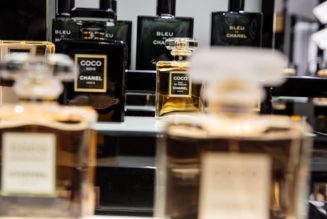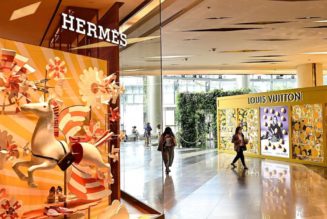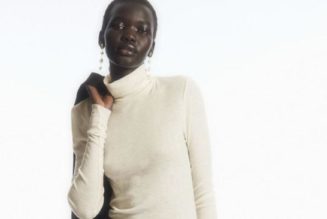MUMBAI — In December 2019, just a few months before Covid-19 hit, I took a hard hat tour of a new luxury mega mall in Mumbai that appeared to be in late stages of construction. This week, almost four years later, Jio World Plaza, part of Indian tycoon Mukesh Ambani’s Reliance Industries, officially opened.
Four years is a long time, but perhaps the timing of the opening could not be better. As the Chinese economy stutters and a slowdown is taking hold in the US and Europe, India is fast emerging as the next burgeoning luxury market. The sense of dynamism and optimism here is palpably different from what is happening elsewhere. More wealth is being created here than ever before, and due to strict capital controls most of that wealth is staying in India and Indians are spending more money at home.
At the grand opening for Jio World Plaza on Tuesday evening, 18 Bollywood “show-stoppers” including fashion plate Sonam Kapoor and mega-star Ranveer Singh, paraded through the mall in a fashion show featuring a who’s who of the Indian designers now part of Reliance’s portfolio, including Rahul Mishra, Anamika Khanna, Manish Malhotra and Abu Jani-Sandeep Khosla.

The expansive development, said to cost more than $1 billion, also includes a cultural centre with a 2,000 seat performing arts theatre which had its own splashy opening earlier this year, a sprawling convention centre and 750,000 square feet of retail space in the heart of the Bandra Kurla Complex (BKC), a business district in the midst of a rapid transformation.
Historically, one of the biggest challenges for luxury brands in India has been the paucity of high-quality retail space to an international standard. When Louis Vuitton opened its first store in India 20 years ago, then CEO Yves Carcelle persuaded the owner of the Oberoi Hotel in New Delhi to convert his office into a small Louis Vuitton boutique.
This week, Vuitton unveiled its largest store in India at Jio World Plaza, with more than 7,000 square feet of retail space. (According to The Times of India, Vuitton will pay 40.5 lakh rupees — about $50,000 — per month for the space. On top of this, Reuters reported that brands in the mall will pay between 4 to 12 percent of their revenues to Reliance.)

The Jio World Plaza also boasts the first Indian stores for Rimowa and Balenciaga, as well as the first Mumbai stores for Valentino, Tory Burch, Saint Laurent, Versace and Tiffany, and large store footprints for Gucci, Dior, Hermès and Cartier.
As a luxury hub for India, the Jio mall is currently unrivalled in its scale and ambition. The thing is, were it not for the store signs written in Marathi script next to the brand’s international logos (as mandated by the Maharashtra state government), I felt like I could have been anywhere in the world. It was just another one of many gleaming marble-clad malls one can find in Singapore, Dubai or Houston.
But about an hour’s drive away down in South Mumbai, the city’s original business district and traditional retail precinct, another kind of luxury shopping hub is developing, closer to the city’s old monied classes, unlike BKC which is more nouveau riche. Already home to the historic Taj Palace Hotel and scores of independent boutiques, this hub doesn’t come with a master plan and coordinated vision like that of the sprawling complex in BKC, but one day it may give Jio World Plaza a run for its money.
The central focus is Horniman Circle, where Hermès, Christian Louboutin and star Indian couturier Sabyasachi Mukherjee have already set up shop. The Circle surrounds a rare public garden in Mumbai, which first developed around the Asiatic Library which was built in 1833, during the time of British colonisation. Eventually, it became the main financial district, and is still home to banks which are being repurposed into grand luxury stores. The colonnaded archways around the curved street are actually walkable (a rarity in the street-level chaos of Mumbai), visually striking and perfect for street-level shopping.
It’s easy to imagine Horniman Circle as a luxury district that could rival that of a European capital, with a distinctly Indian personality. A massive infrastructure boom of new roads and highways, including the massive Coastal Road Project, will soon make South Mumbai more accessible to people in the further reaches of the city too.
Rahul Mishra, who is opening a store in Jio World Plaza in two months, has also signed on a 6,000 square foot space next to Hermès in Horniman Circle set to open in May. And late next year, around the corner in the Turner Morrison building, Paris’ famous Galeries Lafayettes will open the doors of a 90,000 square foot department store, its first outpost in India in partnership with Reliance rival, Aditya Birla Fashion and Retail Limited.
And if the industry chatter here in Mumbai is accurate, Louis Vuitton (which in addition to Jio World Plaza has two other Mumbai stores, including a small boutique in the Taj Palace Hotel), Gucci (which also has three stores in Mumbai, including a sparkling new store in Jio World Plaza and an outpost in the highly productive but outdated Palladium Mall) and Chanel (which does not have a Mumbai store and is noticeably absent from the Jio World Plaza) are all scouting locations near Horniman Circle too. If this were all to come together, Horniman Circle would become Mumbai’s answer to Bond Street, Avenue Montaigne and Fifth Avenue.
Then again, people were telling me similar things on a previous trip here 10 years ago, so it may take some time til the South Mumbai luxury hub takes shape. In the meantime, Jio World Plaza has a big head start and Mumbai’s luxury customers looking for world-class retail finally have somewhere to shop.
The BoF Podcast
The author has shared a Podcast.You will need to accept and consent to the use of cookies and similar technologies by our third-party partners (including: YouTube, Instagram or Twitter), in order to view embedded content in this article and others you may visit in future.

In the lead up to BoF VOICES 2023, we will be sharing some of my favourite conversations from going all the way back to 2016.
This week, we revisit an inspiring conversation with Vanessa Kingori, Condé Nast Britain’s chief business officer who shared her lessons in leadership with purpose coach Mory Fontanez, underscoring the importance of leveraging intuition in leadership and decision making.
“Let your intuition be the starting point. Intuition is about a subconscious understanding of something, but that subconscious understanding comes from somewhere,” Vanessa said at BoF VOICES 2021. “It’s not magic… It’s that you have experienced or observed something that underpins a strong belief.”
BoF VOICES 2023 will be livestreamed for BoF Professional All-Access members from November 28th to November 30th — click here to register now, and use the code 25OFFVOICES2023 to benefit from 25% off your new BoF Professional membership.
Imran Amed, Founder, CEO and Editor-in-Chief, The Business of Fashion
Plus, here are my other top picks from our analysis on fashion, luxury and beauty:
1. Are Sky-High Valuations Back in Fashion? The fundraising landscape is still generally conservative, but companies like Alo Yoga are reportedly seeking multi-billion dollar valuations.

2. Phoebe Philo: The Big Reveal. In Philo’s first looks for her long-awaited namesake label, there’s the luxe minimalism she was known for at Celine, but also a raw, shredded edge which breaks with her immediate past, reveals Tim Blanks after an audience with the designer.

3. Phoebe Philo’s First Drop, Explained. On Monday, the star designer released her namesake label’s first products, serving up ‘Old Celine’ chic spiked with a raunchier undercurrent. BoF breaks down the drop, as well as a go-to-market strategy that couldn’t be further from the standard luxury playbook.

4. Why Shein Keeps Buying Its Rivals. The ultra-fast fashion giant’s latest acquisition of Missguided and partnership with Forever 21 will grant it access to new customers and distribution channels.

5. Why Japanese Beauty Giants Are Buying Up Global Brands. M&A is gathering pace in Japan’s beauty industry as local conglomerates look to diversify their portfolios beyond Asia and target high-growth categories overseas.
:quality(70)/cloudfront-eu-central-1.images.arcpublishing.com/businessoffashion/YYWNSNXWLJELRDARNRQDOA42TI.jpg)
6. Fast Fashion’s M&A Frenzy, Explained. Amid a spending slowdown and steep competition, UK fast-fashion players including Asos and Frasers Group are selling off struggling brands.
:quality(70):focal(956x136:966x146)/cloudfront-eu-central-1.images.arcpublishing.com/businessoffashion/37CTOPX57NBF5JTOTK4ODUSBN4.jpg)
To receive this email in your inbox each Saturday, sign up to The Daily Digest newsletter for agenda-setting intelligence, analysis and advice that you won’t find anywhere else.









